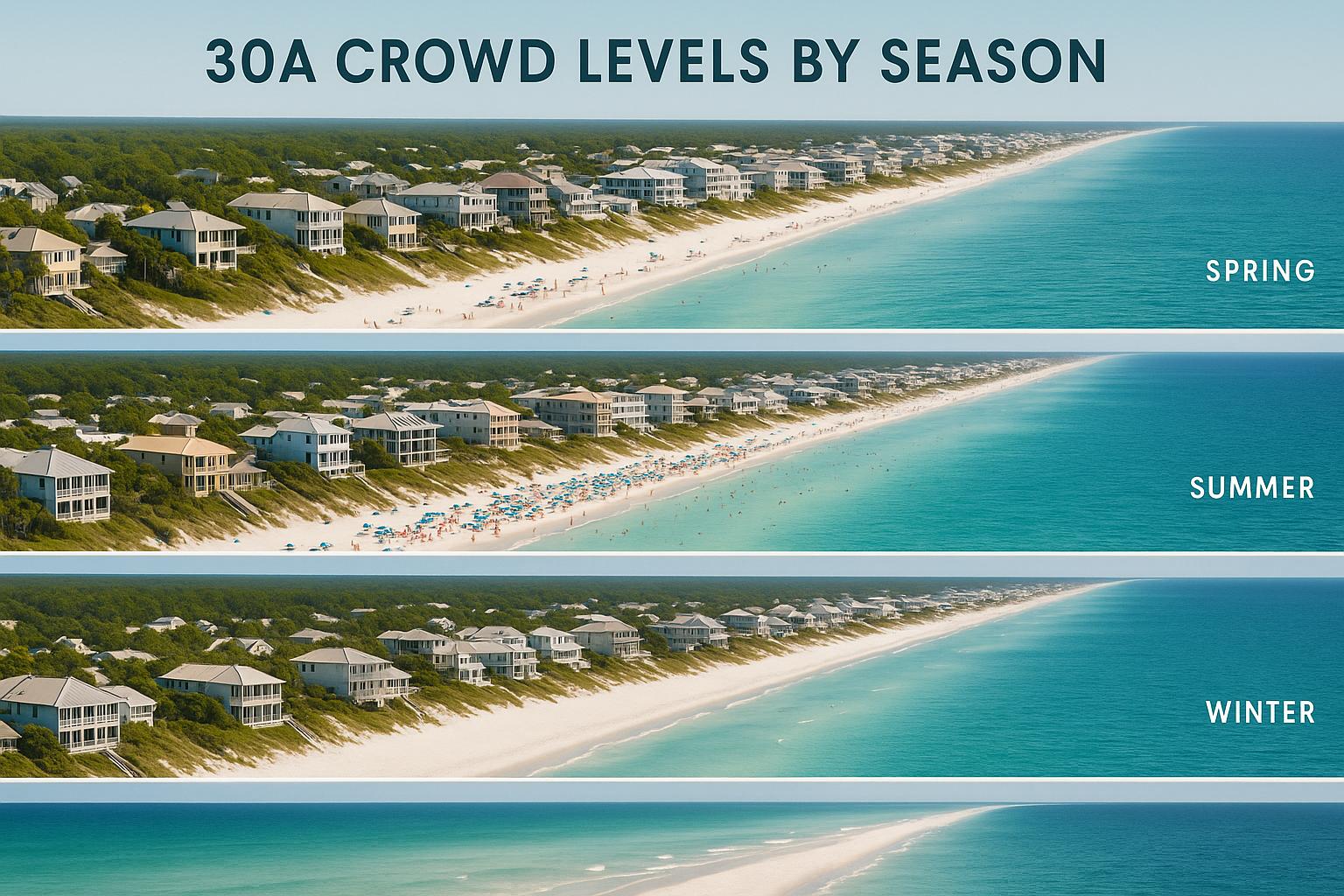Seaside, Florida, is a small community that redefined neighborhood design by prioritizing walkability, mixed-use spaces, and human connection. Designed in the 1980s by Andrés Duany and Elizabeth Plater-Zyberk, it became the foundation of the New Urbanism movement. This approach challenges suburban sprawl by creating compact neighborhoods with interconnected streets, accessible public spaces, and diverse housing options.
Key Takeaways:
- Walkability: Everything is within a 5-10 minute walk.
- Mixed-Use Design: Homes, shops, and offices share space.
- Community Focus: Central squares and public areas encourage interaction.
- Sustainability: Reduced car use and efficient layouts minimize environmental impact.
Seaside’s success inspired similar developments worldwide. However, rising property values have made affordability a challenge, limiting diversity. Despite this, it remains an influential model for urban planning, showing how thoughtful design can create vibrant communities.
The Origins and Principles of New Urbanism
Historical Background of Seaside
Seaside, Florida, stands as a groundbreaking example of intentional community planning that broke away from the norms of traditional suburban development. Designed by architects Andres Duany and Elizabeth Plater-Zyberk, this village drew inspiration from classic American towns and European villages. By studying historic Southern communities, they sought to recreate the close-knit, pre-automobile neighborhood feel, laying the groundwork for what would later become the New Urbanism movement.
This approach was a direct response to the challenges posed by post–World War II suburban sprawl, including economic inefficiencies, health concerns, and environmental degradation. The goal was simple yet ambitious: to design a community that prioritized human connection, reduced reliance on cars, and fostered a deep sense of belonging.
What began as a bold experiment evolved into a set of principles that would redefine urban design.
Core Principles of New Urbanism
At its heart, New Urbanism promotes human-centered design, drawing from the timeless qualities of historic urban environments. The movement emphasizes walkable neighborhoods, mixed-use spaces, and vibrant public areas that encourage interaction and community building.
Andres Duany captured the essence of this philosophy when he said:
"Only when humans are again permitted to build authentic urbanism - those cities, towns, and villages that nurture us by their comforts and delights - will we cease the despoiling of Nature by escaping to sprawl"
The movement's guiding principles can be distilled into ten key concepts:
| Core Principle | Key Features |
|---|---|
| Walkability | All essential destinations are within a 10-minute walk along pedestrian-friendly, tree-lined streets. |
| Connectivity | A grid of interconnected streets disperses traffic and includes narrow streets, boulevards, and alleys. |
| Mixed-Use & Diversity | Integration of shops, offices, apartments, and homes to accommodate a range of ages, incomes, and cultures. |
| Mixed Housing | A variety of housing styles, sizes, and price points to meet diverse needs within close proximity. |
| Quality Architecture & Urban Design | Focus on aesthetic appeal, comfort, and creating a distinct sense of place. |
| Traditional Neighborhood Structure | Defined centers and edges, with public spaces at the core, ensuring all uses are within a 10-minute walk. |
| Increased Density | Compact development enhances walkability and optimizes resource use. |
| Green Transportation | Infrastructure supports walking, cycling, and public transit, reducing dependency on cars. |
| Sustainability | Eco-friendly technologies and respect for natural systems minimize environmental impact. |
| Quality of Life | Combining these elements creates environments that promote community and well-being. |
These principles provide a stark contrast to the single-use, low-density suburban developments that dominated the post-war era.
Seaside's Role in the New Urbanism Movement
Seaside became the living embodiment of New Urbanist principles, showing how these ideas could work in practice. Its design revolves around the concept of a compact, pedestrian-friendly neighborhood, where the entire community is accessible within a five-minute walk from its center to its edges. The layout features a traditional grid pattern, with narrow streets that calm traffic and encourage walking. At the heart of the town lies a bustling center filled with shops, restaurants, and public spaces, serving as a hub for social and economic activity.
The success of Seaside didn't stop at its borders. Its influence rippled across the United States, proving that New Urbanist principles could create neighborhoods that were both economically viable and socially engaging. This success story helped cement New Urbanism as a compelling alternative to the sprawling suburban model, inspiring similar developments nationwide.
Seaside Florida The Town That Changed the Suburbs #SeasideFlorida #CoastalTowns #TravelDocumentary
Architectural and Urban Design Features of Seaside
Seaside brings New Urbanist ideas to life through its thoughtful layout, distinctive architecture, and vibrant community spaces.
Street Layout and Public Spaces
Seaside’s grid layout blends practicality with charm, creating a connected and walkable town. Narrow streets slow down traffic, making the area safer and more inviting for pedestrians. The design centers around a main hub, ensuring that residents are always within a five-minute walk of the town center.
Public spaces are the beating heart of Seaside. The town center features a pavilion that hosts everything from farmers markets to outdoor concerts, while smaller parks and green spaces are sprinkled throughout the neighborhood, offering plenty of spots for neighbors to gather. Easy access to the beach also doubles as shared community space, bringing people together in a natural setting.
A series of pedestrian alleys weaves through the blocks, offering cozy, shaded pathways. These alleys aren’t just practical for walkers and cyclists - they also encourage spontaneous interactions between neighbors.
Architectural Styles and Building Features
Seaside’s architecture captures the essence of the Southern coastal style while incorporating smart, functional design elements. Homes are built with features like deep porches, high ceilings, and carefully placed windows to maximize natural ventilation, cutting down on the need for air conditioning. Elevated foundations protect against flooding and boost airflow, while overhangs and covered porches provide shade to keep homes cool.
The town’s architectural guidelines ensure a cohesive and appealing look. Homes are designed to let in plenty of natural light without overheating, and building heights are kept modest to maintain a human-scale feel. Natural materials - like wood, metal, and stone - are used throughout, paired with soft pastel colors, whites, and natural wood tones. Traditional accents like picket fences and detailed millwork add to Seaside’s charm.
This design philosophy stands in stark contrast to the sprawling, car-centric layout of typical suburban neighborhoods.
Comparison with Conventional Suburbs
Seaside’s design approach highlights the differences between New Urbanism and conventional suburban planning. Here’s how they stack up:
| Design Element | Seaside (New Urbanism) | Conventional Suburbs |
|---|---|---|
| Street Width | Narrow streets with on-street parking | Wide streets dominated by vehicular traffic |
| Street Pattern | Connected grid system | Looped streets and cul-de-sacs |
| Accessibility | Walkable distances to amenities | Dependence on driving for daily needs |
| Housing Density | Higher density, compact layout | Lower density, spread-out homes |
| Building Setbacks | Minimal setbacks for a close-knit feel | Large setbacks separating structures |
| Parking | Shared or on-street parking options | Private driveways and garages |
| Public Spaces | Central squares and pocket parks | Few communal areas |
| Mixed Use | Integrated homes, shops, and offices | Segregated residential and commercial zones |
Seaside’s compact design doesn’t just make life more convenient - it’s also cost-effective. Shared infrastructure and reduced reliance on cars cut transportation costs, while the walkable layout boosts local businesses. Design choices like front porches and narrow sidewalks naturally encourage social interactions, and the central town square acts as a lively gathering spot.
From an environmental perspective, Seaside’s reduced car use and smaller building footprints help preserve green spaces and minimize impact. This carefully planned development creates a vibrant, sustainable community where people can genuinely connect and thrive.
sbb-itb-d06eda6
Impact of Seaside on Planning and Culture
Seaside's influence extends far beyond the 30A corridor. While the town's original vision of walkable, mixed-use neighborhoods has reshaped urban design, its economic success has introduced challenges that complicate its founding ideals.
Influence on Urban Planning
Seaside has become a touchstone for urban planners, showcasing the advantages of walkable, mixed-use communities. Urban planner Andres Duany, one of Seaside's original designers, highlighted its significance:
"Seaside demonstrates how neighborhood design can foster social interaction and improve the quality of life."
The town’s design has inspired countless New Urbanist developments, proving that people crave alternatives to sprawling suburban layouts. This success has not only influenced urban planning but also sparked notable economic shifts in the area.
Economic Impact and Community Challenges
Seaside’s New Urbanist design has brought economic prosperity, but it has also created significant challenges. Property values have skyrocketed, with homes now averaging $1,300 per square foot - nearly double the $700 per square foot in neighboring Old Seagrove. Vacant lots are listed at over $700,000, and completed homes sell between $1.5 million and $3.5 million. On average, New Urbanist communities command a 14.9% price premium over comparable properties, but Seaside’s premium is even higher, making it a haven for affluent buyers.
This surge in property values has led to a shortage of affordable housing. Many service workers must commute from distant areas due to the lack of workforce accommodations. Additionally, economic segregation is evident, with Seaside struggling to attract ethnically and economically diverse residents. While the town’s businesses often cater to a predominantly white clientele, much of the workforce comprises Black, Indigenous, and people of color.
Pop Culture and Media Legacy
Despite these challenges, Seaside’s cultural significance continues to captivate. Known as a landmark in architecture and urban planning, its impact on pop culture remains underexplored. More research is needed to fully understand how Seaside’s media presence has shaped modern urban design and cultural narratives.
Visiting Seaside Today
Seaside is a charming destination that continues to draw visitors eager to experience its renowned role in shaping New Urbanism. Its compact, walkable design invites exploration on foot, offering a firsthand look at a community built to encourage close social ties and a lively local atmosphere. Here’s what you need to know to make the most of your visit.
Visitor Essentials and Tips
Parking along Scenic Highway 30A can be a challenge during busy times, so arriving early is a smart move. One of the best ways to truly appreciate Seaside’s thoughtful design is by taking a self-guided walking tour. The town’s carefully planned public spaces and pedestrian-friendly streets showcase its New Urbanist ideals. For a quieter experience, consider visiting during off-peak hours when the pace is more relaxed.
Dining, Shopping, and Local Experiences
Seaside’s town center is a perfect reflection of its New Urbanist roots, blending mixed-use spaces with pedestrian-focused streets. Dining options cater to all tastes, from refined restaurants serving regional dishes to laid-back cafés with a coastal flair. The boutique shops and community markets are equally inviting, offering locally crafted goods in a setting that’s as enjoyable to explore as it is to shop.
Seasonal Events and Community Activities
Adding to its walkable appeal, Seaside boasts a lively schedule of events throughout the year. The town regularly hosts outdoor concerts, performances, and seasonal festivals, all designed to bring people together and celebrate its distinctive character. These gatherings make use of the thoughtfully designed public spaces, highlighting the town’s dedication to fostering a sense of community.
If you’re venturing beyond Seaside, check out sowal.co for detailed guides to hidden beaches, dining spots, and events across South Walton. It’s a great resource for understanding how Seaside’s New Urbanist vision continues to influence the wider 30A area.
The Lasting Legacy of Seaside and New Urbanism
Seaside began as an ambitious experiment in the 1980s, but it has since transformed the way communities are designed. Created by architects Andrés Duany and Elizabeth Plater-Zyberk, the town was envisioned as a walkable, human-centered neighborhood. This vision helped spark a broader movement in urban planning, influencing designs both across the U.S. and globally.
The town's compact, mixed-use layout became a model for creating pedestrian-friendly spaces. With inviting front porches, tree-lined streets, and central gathering spots, Seaside’s design encourages social interaction and a sense of belonging. It’s a reminder that thoughtful planning can create spaces where people connect, rather than just coexist. This approach has inspired many communities to embrace similar principles, while prompting municipalities to rethink zoning rules to better integrate residential, commercial, and civic spaces.
Seaside’s impact goes far beyond its picturesque aesthetics. It has shown that great design is about fostering human connection and building vibrant communities. Decades after its founding, the town remains a symbol of the desire for walkable, socially connected neighborhoods. As urban planners grapple with issues like suburban sprawl, climate change, and social isolation, Seaside’s model offers valuable lessons. Its principles continue to evolve, addressing modern challenges while staying true to the core idea of people-focused, community-centered design. Seaside stands as proof that well-planned, human-scale neighborhoods can create lasting, thriving communities.
FAQs
What role did Seaside, Florida play in shaping the New Urbanism movement?
Seaside, Florida, stands out as a trailblazer in the New Urbanism movement, demonstrating how carefully planned communities can redefine urban living. As the first fully realized embodiment of New Urbanism, Seaside focused on walkable neighborhoods, mixed-use spaces, and traditional design elements, striking a thoughtful balance between practicality and aesthetic appeal.
This forward-thinking model has inspired architects and urban planners across the globe to reconsider how cities are built, emphasizing designs that promote community connections, human-scale living, and sustainable practices. Even today, Seaside serves as a shining example of how to create thriving, livable neighborhoods that blend modern lifestyles with enduring design principles.
What challenges does Seaside face due to rising property values, and how do they impact community diversity?
Seaside, Florida, is grappling with a tough issue: skyrocketing property values. The soaring cost of housing is making it increasingly out of reach for middle- and lower-income families, which, in turn, is reshaping the community. This change chips away at the economic diversity that once added vibrancy to the area and limits the chance for a broader mix of people to call Seaside home.
As home prices climb, wealthier buyers are drawn in, creating a shift in the local demographic. Unfortunately, this often comes at the expense of social and cultural diversity, which was a cornerstone of the New Urbanism philosophy that inspired Seaside's design. This movement envisioned neighborhoods where people from various income levels could live side by side. The real challenge now is finding a way to manage Seaside's growth and popularity without losing the inclusive and welcoming character that was at the heart of its original purpose.
What makes Seaside, Florida, a standout example of walkable and sustainable urban design?
Seaside, Florida, stands out for its smart design that puts walkability front and center. With its compact layout, pedestrian-friendly streets, smaller lot sizes, and traffic-calming features, the town encourages walking as the go-to way to get around. This not only cuts down on car use but also helps build a stronger sense of community.
A key part of Seaside's design is its use of form-based code, which ensures a unified, human-scale environment. This approach enhances social interaction, improves environmental efficiency, and makes the town more accessible - key principles of New Urbanism. By combining thoughtful planning with eco-conscious elements, Seaside has become a shining example of how to create lively, walkable neighborhoods.



